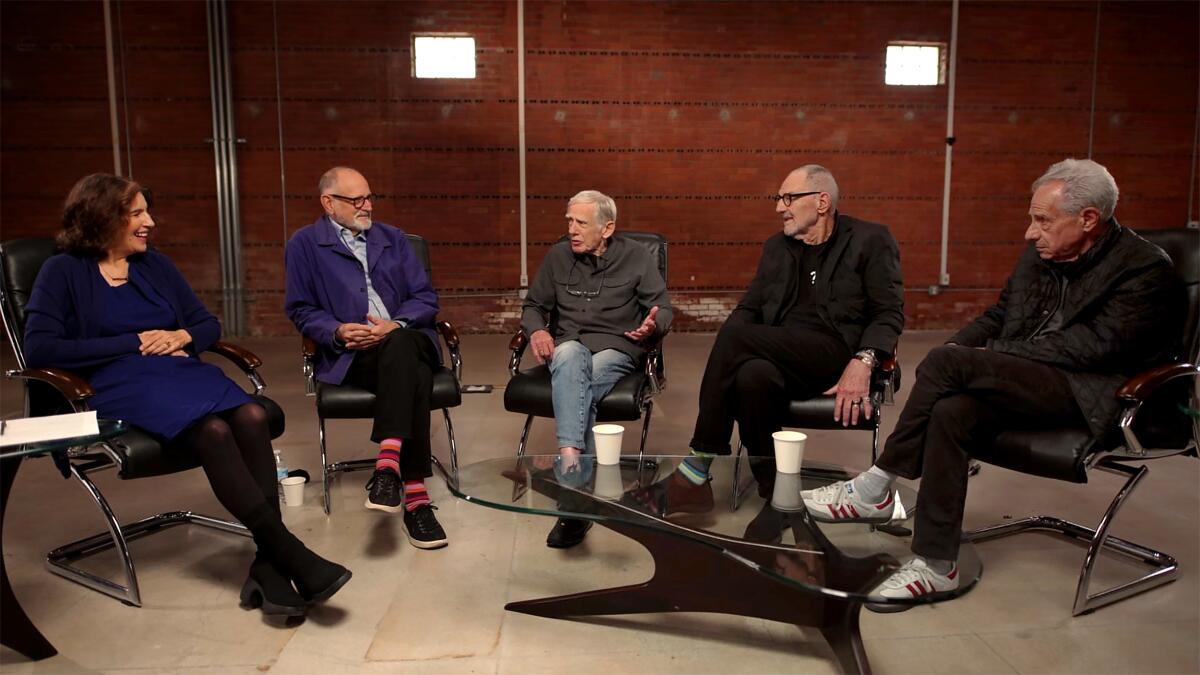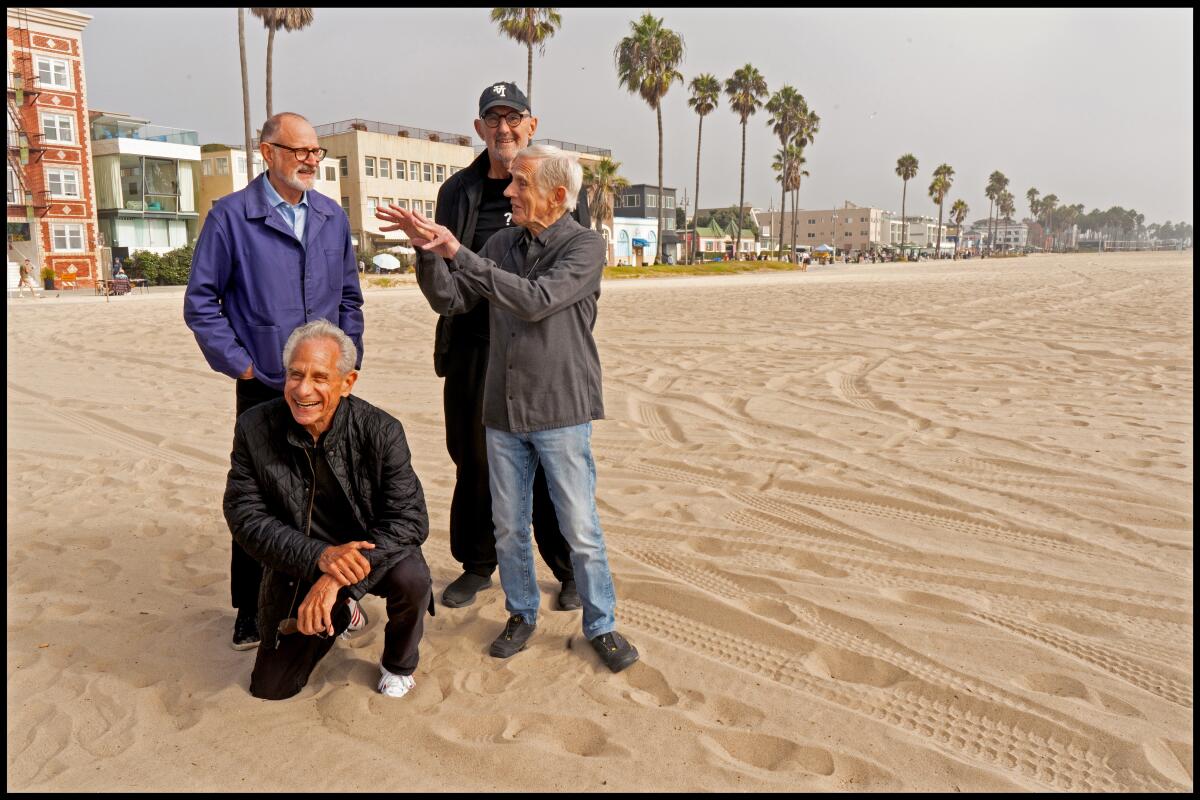On a wide, empty stretch of Venice Beach in 1980, seven Los Angeles architects — Frank Gehry, Thom Mayne, Eric Owen Moss, Coy Howard, Craig Hodgetts, Robert Mangurian and Frederick Fisher — gathered for a group portrait by photographer Ave Pildas. Clad in mismatched outfits and standing casually in the sand, they looked more like a rumpled rock band than the future of American architecture.
The resulting image, published in Interiors magazine, distilled a seismic moment in L.A.’s creative history. Those seven, gazing in their own directions yet joined in a sense of mischievous rebellion and cocky exuberance, represented a new generation that was bringing a brash, loose creativity to their work and starting to distance itself from the buttoned-up codes and expectations of the architecture establishment.
Each would go on to have a successful career, from Pritzker Architecture Prize winners to directors of architecture schools. And they and their compatriots would, for a while at least, help put a rapidly changing L.A. at the center of the built culture.
“That one photograph contains a whole world,” notes filmmaker Russell Brown, who recently directed a 12-part documentary series about that Venice architecture scene. “There was risk going on, and freedom; it was all about ideas.”
“It’s become a kind of reference point,” adds architectural journalist Frances Anderton, host of the series. “It just keeps reappearing whenever there’s a conversation about that period.”
The 1980 image is the jumping-off point for “Rebel Architects: From Venice to the World Stage,” produced by Brown’s nonprofit, Friends of Residential Treasures: Los Angeles. Four of the architects — now in their 70s and 80s — gathered for a (far less brash) new photo and an honest conversation about their early careers in L.A., and what’s transpired since for the series, which began streaming monthly on FORT: LA’s website July 1.
A native Angeleno with a background in feature and documentary filmmaking, Brown conceived of the concept after a chat with architect Robert Thibodeau, co-founder of Venice-based DU Architects. After a deeper dive into the image with Anderton, the idea for a reunion was born.
“We thought, why don’t we restage the photo and then use that as an excuse to get the guys together?” Brown explains.
He preferred a spontaneous, lighthearted group discussion to the typical documentary, with its one-on-one interviews and heavy production.

Frances Anderton, from left, Frederick Fisher, Craig Hodgetts, Thom Mayne and Eric Owen Moss catch up for “Rebel Architects,” a 12-part series.
(FORT: LA)
“It’s about the chemistry between creative peers,” says Brown. “The real legacy of these architects isn’t just in the buildings. It’s in the conversations they started — and are still having.” He added: “There’s a spark that happens when they’re together … They talk about failure, competition, teaching, aging. It’s a very human exchange.”
Episode 1, titled “Capturing a Moment in L.A. Architecture,” opens with four of the surviving architects — Fisher, Mayne, Moss and Hodgetts — recreating that seminal photograph for Pildas and sitting down for an interview. (Howard was interviewed separately, Gehry declined and Mangurian died in 2023.) The group dissects the photo’s cinematic, informal composition, in which Pildas aims down from a berm, the neglected buildings behind the eclectic crew shrinking into the horizon, merging with the sand. And they remember a time in which the city’s messy urban forms and perceived cultural inferiority provided endless creative fuel, and liberation.
Pildas recalls how the original shoot came together at the request of British design editor Beverly Russell, who was looking to capture “Frank Gehry and some of his Turks.” (The international design press was gaga for L.A. at the time. Anderton notes that her move from the U.K. resulted from a similar assignment, on the “subversive architects of the West Coast,” for the publication Architectural Review in 1987.)
At the time, most of the architects were working in garages and warehouses, forming their studios and collaborating with equally norm-busting and (relatively) unheralded artists in the scrappy, dangerous, forgotten, yet exploding Venice scene. In a later episode, the architects start listing the art talents they would run into, or befriend, including Larry Bell, James Turrell, Ed Ruscha, Fred Eversley, Robert Irwin, Robert Rauschenberg and Jean-Michel Basquiat, to name a few.
Basquiat was then living and working in Hodgetts’ building. “It was a spectacular fusion of all this creative energy,” Hodgetts remembers. “There was no audience, there were no guardrails, and one did not feel constrained.” He adds, later: “We all felt like we were marooned on a desert island.”
Pildas, who had studied architecture before switching to design and, eventually, photography, was uniquely suited to capture the group. He had shot some of the small, quirky experiments of Mangurian and Mayne, and knew most of the others through social and professional circles. (He even knew Hodgetts from high school back in Cincinnati.)
The first attempt at the photo seemed stiff, says Pildas, so he took out a joint, which all except Hodgetts accepted, he says. The icebreaker worked. In a later image, says Pildas, Fisher is hugging Gehry’s leg, the others huddled around. “It got pretty friendly in the end,” he jokes.
Pildas argues that the photo is much more layered with meaning (not to mention nostalgia) now than it was at the time. “Back then, it was just another magazine shoot. Now, it’s history,” he says. Adds Moss: “Its relevancy, or not, is confirmed by the following years. Otherwise it’s gone.”

Frederick Fisher, from left, Thom Mayne, Craig Hodgetts and Eric Owen Moss recreate their famous 1980 photo.
(Ave Pildas)
Each episode explores the image’s layers, and the unfolding stories that followed — the challenges of maintaining originality; crucial role of journalists in promoting their work; maddening disconnect between L.A.’s talent and its clients, along with the mercurial, ever-evolving identity of Los Angeles. The tone, like the photo, is unpretentious and playful, heavy on character and story, not theory. This was not always an easy task with a group that can get esoteric quite quickly, adds Anderton. “I was trying to keep it light,” she laughs. “I don’t think I even have the ability to talk in the language of the academy.”
“They’re cracking jokes, interrupting each other, reminiscing about teaching gigs and design arguments,” says Brown. “There’s real affection, but also a sense of rivalry that never fully went away.” Hodgetts doesn’t see it that way, however. “It was really about the joy of creating things. We wanted to jam a bit, perform together; that’s really life-affirming,” he says.
There are some revealing moments. Mayne, whose firm Morphosis is known for bold, city-altering buildings such as Caltrans HQ in downtown L.A., reflects on teaching as a way of “being the father I never had.” (His father left his family when he was a young boy.) He tenderly discusses the seminal role that his wife Blythe — a co-owner of Morphosis — has played in his career. Fisher reveals that Gehry was the chief reason he dropped everything to come out to L.A. (At the time, he was working as a display designer at a department store in Cincinnati.) “I remember seeing this architect jumping up and down on cardboard furniture. I could see there was something going on here. Something percolating,” he says. Moss opens up about his struggles to negotiate the demands of the practical world, while Hodgetts performs brilliant critiques of the others’ work, sometimes to broad smiles, others to cringes.
Notably absent from the reunion is Gehry himself, who is now 96. “He’s at a point in his life where trudging through sand for a photo wasn’t going to happen,” says Brown. “But his presence is everywhere. He’s still the elephant in the room.”
One episode explores how Gehry, about a decade older than the others, both profoundly influenced and often overshadowed the group — a reality that was perhaps reinforced by his nonchalant dominance in the photo itself. “Frank takes up a lot of oxygen,” Mayne quips. Still, all admire Gehry’s unwillingness to compromise creatively, despite often heavy criticism.
Another prevailing theme is the bittersweet loss of that early sense of freedom, and the Venice of the 1970s, with its breathtakingly low rents and abandoned charm. Today’s architects — wherever they are — face higher stakes, infinitely higher costs and tighter regulations.
“The Venice we grew up with is completely gone,” says Fisher. “But maybe it’s just moved,” noted Moss. Distinguishing L.A. as a place whose energy and attention is constantly shifting, he wonders if creative ferment might now be happening in faraway places like Tehachapi — “wherever land is cheap and ambition is high,” he says.
While Pildas was capturing the seven architects 45 years ago, he was also busy chronicling the city’s street culture — jazz clubs, boulevard eccentrics, decaying movie palaces and bohemian artists. All were featured in the 2023 documentary “Ave’s America” (streaming on Prime Video) directed by his former student, Patrick Taulère, exploring his six decades of humbly perceptive, deeply human work.
After reviewing the recreation of the photo — the architects are still smiling this time, but their scrappy overconfidence feels eons away — Pildas wonders who the next generation will be, and how they will rise.
“Maybe it’ll happen that they’ll have another picture someday with a bunch of new architects, right?” he says. “This is a fertile ground for architecture anyway, and always has been.”
Exposing that “fertile ground” to Angelenos of all kinds is FORT: LA’s overarching goal. Founded in 2020, it offers architecture trails, fellowships and a surprising variety of programming, from design competitions to architecture-themed wine tastings. All, says Brown, is delivered, like “Rebel Architects,” with a sense of accessible joy and exploration — an especially useful gift in a turbulent, insecure time for the city.
“Suddenly, you kind of think about the city in a different way and feel it in a different way,” says Brown. “This is a place that allows this kind of vision to come to life.”